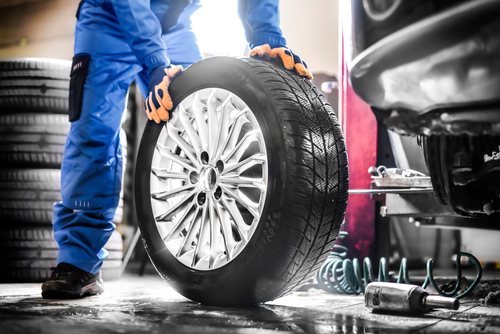When to Replace Your Tires: Signs of Wear and Aging
April 4, 2024 1:52 pm Leave your thoughts
One of the most important aspects of vehicle maintenance is ensuring that your tires are in good condition. Your tires are the only contact between your vehicle and the road, so having worn or aged tires can compromise your safety and the performance of your car. It’s crucial to know when it’s time to replace your tires to avoid accidents and ensure that your vehicle is running smoothly. In this blog, we will discuss the signs of wear and aging that indicate you need to replace your tires.
Tread Depth
One of the most common ways to tell if your tires need to be replaced is by checking the tread depth. The tread on your tires is what provides traction and grip on the road, especially in wet or slippery conditions. The legal minimum tread depth in most states is 2/32 of an inch, but it’s recommended to replace your tires when the tread depth reaches 4/32 of an inch for better safety and performance.
To check the tread depth of your tires, you can use a tread depth gauge or the penny test. Simply place a penny upside down in the tread grooves of your tires. If you can see the entire top of Lincoln’s head, it’s time to replace your tires. Worn-out tread can lead to reduced traction, longer stopping distances, and an increased risk of hydroplaning, so it’s essential to replace your tires when the tread depth is low.
Uneven Wear
Another sign that your tires need to be replaced is uneven wear. Uneven wear patterns can indicate issues with your vehicle’s alignment, tire pressure, or suspension system. Common patterns of uneven wear include cupping, feathering, and camber wear. Cupping is when there are scalloped dips on the tire tread, feathering is when the edges of the tread are worn down, and camber wear is when the insides or outsides of the tires wear more quickly than the rest of the tread.
If you notice any of these patterns of uneven wear on your tires, it’s crucial to have them inspected by a professional and replace them if necessary. Driving on tires with uneven wear can lead to reduced handling, poor ride quality, and a higher risk of blowouts. Regularly checking for uneven wear and addressing any alignment or suspension issues can help extend the lifespan of your tires and keep you safe on the road.
Cracks and Bulges
Cracks and bulges on the sidewalls of your tires are another sign that they need to be replaced. Cracks can develop due to aging, exposure to the elements, or underinflation. Cracks weaken the sidewalls of the tires, making them more susceptible to blowouts and flats. Bulges, on the other hand, typically indicate internal damage to the tire, such as a broken belt or separation of the layers.
If you notice any cracks or bulges on your tires, it’s essential to have them inspected by a professional and replace them as soon as possible. Driving on tires with cracks or bulges can be dangerous and increase the risk of a blowout, especially at high speeds. Regularly inspecting your tires for signs of damage and addressing them promptly can help ensure your safety and the longevity of your tires.
Age of the Tires
In addition to the signs of wear and damage mentioned above, the age of your tires is also an important factor to consider when deciding whether to replace them. Tires have a limited lifespan, even if they appear to be in good condition. The rubber compounds in tires degrade over time, especially if the tires are exposed to sunlight, heat, or harsh weather conditions.
Most tire manufacturers recommend replacing tires every 6 to 10 years, regardless of the tread depth or overall condition. You can check the age of your tires by looking at the DOT (Department of Transportation) number on the sidewall. The last four digits of the DOT number indicate the week and year of production. If your tires are older than 6 years, it’s recommended to have them inspected by a professional and consider replacing them to ensure your safety on the road.
Summary
Knowing when to replace your tires is crucial for maintaining the safety and performance of your vehicle. By regularly checking the tread depth, looking for signs of uneven wear and damage, and considering the age of your tires, you can ensure that your tires are in good condition and replace them when necessary. Investing in new tires when needed can help prevent accidents, improve handling and traction, and extend the lifespan of your vehicle. If you’re unsure about the condition of your tires, it’s always best to have them inspected by a professional to ensure your safety on the road.
Need an Auto Body Shop in Middletown, NJ?
Family owned and established in 1953, Lentz Auto Body has been serving Belford and Middletown for over 60 years. Here at Lentz Auto Body, we provide superior, experienced service for your vehicle. Now with all new ownership and management, Lentz Auto Body is your one-stop shop for all things collision repair and body work. Some of our major services include collision and auto body repair, dent repair, auto restoration, auto painting, custom auto painting, car detailing, and more! If you need collision repair or auto body services in Middletown, give us a call or stop in today for an estimate. Our friendly staff and professional mechanics are here, waiting to assist you!
Categorised in: Auto Maintenance
This post was written by admin
